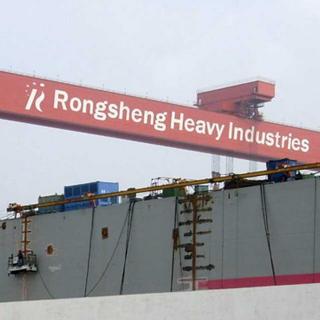
介绍:
Rattled by allegations of padded order books and other questionable business practices, Jiangsu Rongsheng Heavy Industries Group Co. is teetering on bankruptcy. Formerly China’s largest shipbuilder, the remaining workers at the company’s shipyards say that they haven’t been paid since last November.
The company once employed 30,000 people, but now only a few hundred workers labor away in its shipyard. Its third-quarter 2014 financial report showed that the company posted losses of 2.4 billion yuan, with 31.3 billion yuan in liabilities and 7.6 billion yuan of outstanding short-term debt. The debt pressures began several years ago, sources say, and continued to balloon on murky bookkeeping methodology.
An executive at the company said founder and former chairman Zhang Zhirong pushed for an expansion plan that moved investment into the real estate sector. Zhang worked as a property developer in the 1990s. The executive said Rongsheng went too far in its spending. From 2008 to 2011, the shipbuilder set aside between 1.5 to 5.4 billion yuan every year for fixed-asset investments. From 2011, company started to flounder on mounting debt and an inability to call on credit after banks found the company exaggerated records with fake orders. Among several allegations, sources say a canceled ship order by Greek company Thenamaris Ships was later paid for by Zhang to the tune of US$ 72 million, in a bid to boost Rongsheng’s market confidence ahead of IPO preparations.
In May of last year, the Jiangsu Province government attempted to arrange a bailout by sponsoring a meeting between the company and China State Shipbuilding Corp. (CSSC). A source at CSSC said the state-owned shipbuilder decided to forego cooperation based on Rongsheng’s heavy debt, adding that it would cost at least 5 billion yuan to merely restart operations at the company’s facilities.
For Caixin Online, this is Diana Bates.
2009年7月,一家名为Roxen Shipping的公司接下了希腊船东Thenamaris Ships在熔盛重工订造的一艘15.6万吨级苏伊士型油轮,并将该船命名为“Roxen Star”号。这艘油轮本应在2008年7月31日交付使用,却因熔盛内部管理问题迟迟无法交付,希腊船东最终弃船。当时,成立刚刚三年多的熔盛正为上市而努力。一旦弃单问题暴露,熔盛在投资者、银行和地方政府的信用将大打折扣。
为了规避危机,最好有人能接下这艘船。Roxen Shipping和它的老板关雄适时出现了。但多位熔盛内部人士说,真正出钱的是时任熔盛董事长张志熔。
此后,弃船现象不断发生。关雄的公司多次接下被弃掉的订单,或直接给熔盛下单,订单总值高达20亿美元(约合120亿元人民币)。这些订单成功掩盖了熔盛的危机,为熔盛从2009年以来的逆势扩张提供了助力。熔盛连续四年手持订单数蝉联全国第一,以获取地方政府、投资者以及银行的资金支持,直至最终资金链断裂,游戏无法继续。
2015年1月4日, 一艘名为“ORE NINGBO”号的40万吨级超大型矿砂船(VLOC)缓缓驶离位于江苏如皋长青沙岛的江苏熔盛重工有限公司(熔盛重工)舾装码头,前往舟山六横岛。这艘甲板面积超过三个足球场的全球最大船舶,将在那里交付给巴西矿商淡水河谷。
随之远去的是张志熔的“船王”梦。“ORE NINGBO”号是熔盛重工为巴西矿业巨头淡水河谷建造的16艘同类型VLOC的最后一艘,它比协议约定的交付时间晚了整整三年。在它身后,曾有3万多名工人的熔盛重工冷冷清清,空地上到处堆满了生锈的船舶分段。
2005年成立后迅速成长为中国第一大民营船企的熔盛重工,现在离破产只有一步之遥。
熔盛重工的老板张志熔以造船闻名,早年做地产起家。1994年,他在上海成立弘耘置业,后与其父张德煌控制的上海地通建设等成立上海阳光集团,这是2009年赴港上市的恒盛地产的前身。2000年,张志熔曾有意进入钢铁业,但2001年结识时任上海外高桥造船有限公司总经理陈强后,他转向了造船业。陈强告诉他:“钢铁业被国家限制,而造船业现在还很落后,又受到国家扶持,市场空间很大。”
熔盛重工在银行业金融机构的总负债是204亿元,牵涉14家银行、3家信托、3家金融租赁公司。早在2014年2月,熔盛重工已有部分贷款逾期,国开行率先抽贷,之后江苏金融办强力介入,设立了20亿元的续贷资金池帮助其应对短期流动资金周转,但资金在2014年8月即已告罄。
大家还在听

